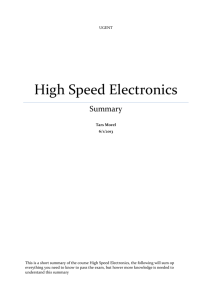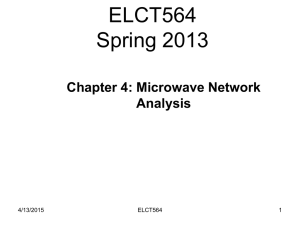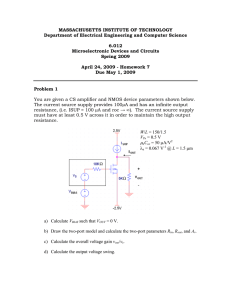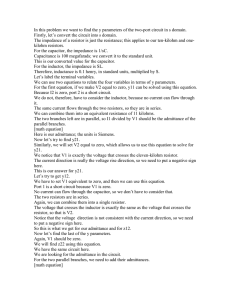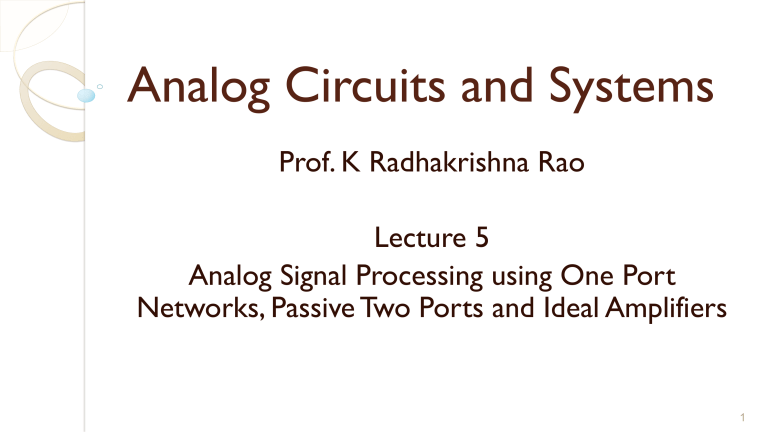
Analog Circuits and Systems Prof. K Radhakrishna Rao Lecture 5 Analog Signal Processing using One Port Networks, Passive Two Ports and Ideal Amplifiers 1 One Port Devices Passive devices like R, L, C and diodes Active Device - Negative resistance – Characteristics and applications 2 Differential Equations: Solutions First Order Differential Equation 3 Differential Equations: Solutions (contd.,) Second Order Differential Equation 4 Linear Two-port Networks Aim Two port network parameters - Y, Z, g and h Immittance Matrix parameters – p Characteristics of two port passive networks Characteristics of two port active networks Controlled sources/amplifiers 5 Nature of Two-port Networks 6 Input port Inputs can be active one-port network like a transducer output of another signal processing two-port network Input source can be represented as ideal voltage source in series with impedance ZS ideal current source in shunt with admittance YS 7 Output port Output may be connected to a load the input port of another signal processing network 8 Two-port Network Characterized by four variables: two at the input port as input voltage Vi and input current Ii Any two variables can be independent and the other two will become dependent variables Two equations between the two dependent variables and the two independent variables characterize the two-port network 9 Two-port Network Parameters Six combinations of independent/dependent variables are possible. The parameters associated with these six combinations are Y, Z, g, h and ABCD and S If one is restricted to use one independent variable at the input and one at the output port then only the parameters Y, Z, g and h are of interest ABCD and S parameters are primarily used for studying microwave networks. 10 g, h,Y and Z parameters g and h are hybrid parameters involving admittance, impedance, voltage ratio and current ratio Y has all admittance (short-circuit) parameters Z has all impedance (open-circuit) parameters 11 Matrix representation of Two-port networks ⎡ Ii ⎤ ⎡ g i = ⎢ V ⎥ ⎢g ⎣ o⎦ ⎣ f g r ⎤ ⎡ Vi ⎤ , ⎥ ⎢ ⎥ g o ⎦ ⎣ Io ⎦ ⎡ Vi ⎤ ⎡ h i = ⎢ I ⎥ ⎢h ⎣ o⎦ ⎣ f ⎡ Ii ⎤ ⎡ Yi = ⎢I ⎥ ⎢Y ⎣ o⎦ ⎣ f Yr ⎤ ⎡ Vi ⎤ ⎡ Vi ⎤ ⎡ Zi , = ⎥ ⎢ ⎥ ⎢ ⎥ ⎢ Yo ⎦ ⎣ Vo ⎦ ⎣ Vo ⎦ ⎣ Zf h r ⎤ ⎡ Ii ⎤ ⎥ ⎢ ⎥ h o ⎦ ⎣ Vo ⎦ Z r ⎤ ⎡ Ii ⎤ ⎥ ⎢ ⎥ Zo ⎦ ⎣ I o ⎦ 12 Immittance Parameters Y, Z, g and h can be generally represented as p- immittance parameters Input current relating to input voltage is input self-immittance pi Output current related to output voltage is known as output selfimmittance po Input related to output is called forward transfer parameter pf Output related to input is known as reverse transfer parameter pr 13 Parameters of Two-port Passive Networks Forward parameter is the same as reverse parameter it is exactly the same in the case of Z and Y parameters in the case of h and g parameters the sign is reversed 14 Ideal controlled sources are known as amplifiers have zero input power and deliver finite output power have infinite power gain For the input power to be zero it should have Zero input current to the amplifier (zero input admittance) Zero input voltage to the amplifier (zero input impedance) 15 Ideal Amplifiers Input is voltage controlled (zero input admittance) or current controlled (zero input impedance) Output is a voltage sources (zero output impedance) or current source (zero output admittance) 16 Types of amplifiers Voltage Controlled Voltage Source (Voltage Amplifiers) (VCVS) Current Controlled Current Source (Current Amplifier) (CCCS) Voltage Controlled Current Source (Transconductance Amplifier) (VCCS) Current Controlled Voltage Source (Transresistance Amplifier) (CCVS) 17 Ideal amplifiers Can be represented only by one of the four parameters ⎡0 VCVS by g-parameter ⎢ ⎣g f ⎡0 CCCS by h-parameter ⎢ ⎣h f ⎡0 VCCS by Y-parameter ⎢ ⎣G f 0⎤ 0 ⎥⎦ ⎡0 CCVS by Z-parameter ⎢ ⎣R f 0⎤ 0 ⎥⎦ 0⎤ 0 ⎥⎦ 0⎤ 0 ⎥⎦ 18 Ideal Amplifiers ⎡0 Immittance matrix = ⎢ p ⎣ f 0⎤ ⎥ 0⎦ They all have zero reverse transmission parameters ( pr ) , which means the device is unilateral. 19 Two-port networks:Y-parameters Ii =Vi Yi +Vo Yr Io =Vi Yf +Vo Yo 20 Example 1 ⎡ Ii ⎤ ⎡ Yf -Yf ⎤ ⎡ Vi ⎤ ⎢ I ⎥ = ⎢-Y Y ⎥ ⎢ V ⎥ f ⎦⎣ o⎦ ⎣ o⎦ ⎣ f Forward transfer admittance = reverse transfer admittance 21 Example 2 1+sCR 2 ⎡ ⎢ R +R +sCR R 1 2 1 2 ⎢ [Y] = -1 ⎢ ⎢ R +R +sCR R ⎣ 1 2 1 2 -1 ⎤ ⎥ R1 +R 2 +sCR1R 2 ⎥ 1+sCR1 ⎥ ⎥ R1 +R 2 +sCR1R 2 ⎦ 22 Example 3: Load and source immittances Ii =Vi Yi +Vo Yr ; Io =Vi Yf +Vo Yo Io Vo =; Io =-Vo YL ; -Vo YL =Yf Vi +Yo Vo and YL Vo Yf =Vi Yo +YL 23 Example 3 (contd.) Yf Yf Yr Ii =Yi Vi Yr Vi ; Ii Vi =Yin =input admittance =Yi Yo +YL Yo +YL 1 ⎡ 1 + ⎢R RS f [Y] = ⎢ ⎢ -1 ⎢ R ⎣ f ⎤ ⎥ ⎥ 1 1 ⎥ + ⎥ Rf RL ⎦ -1 Rf Io =output admittance for a source admittance YS Vo Io IS 1 Yf Yr 1 1 Yout = =Yo = ; Yin = = + Vo Yi +YS R f +R S Vi R S R f +R L 24 Example 3 (contd.) Voltage gain of the two port (for a given YL ) 1 Rf ) Vo ( -Yf 1 Av = = = = Vi YL +Yo (1 R L ) + (1 R f ) 1+ ( R f R L ) 1 RL ) Io -A v YL ( -1 Current gain = = = = −1 Ii Yin 1+ ( R f R L ) (1 ( R f +R L ) ) 25 Two-port network - Z-Parameters Vi =Zi Ii +Zr Io Vo =Zf Ii +Zo Io 26 Example 1 ⎡ Vi ⎤ ⎡ Z Z⎤ ⎡ Ii ⎤ = ⎢ V ⎥ ⎢ Z Z⎥ ⎢ I ⎥ ⎦⎣ o⎦ ⎣ o⎦ ⎣ 27 Example 2: p network ⎡ R1 ( R 2 +R 3 ) ⎢ R +R +R 1 2 3 ⎢ [ Z] = ⎢ R1R 3 ⎢ ⎢⎣ R1 +R 2 +R 3 ⎤ R1R 3 ⎥ R1 +R 2 +R 3 ⎥ R 3 ( R1 +R2 ) ⎥ ⎥ R1 +R 2 +R 3 ⎥⎦ 28 Source and Load Immittances Z r Zf Zin =Zi Zo +ZL Z r Zf Zout =Zo Zi +ZS Io -Zf A I = = current gain = Ii ZL +Zo Io ZL ZL Av = =A I Ii Zin Zin 29 Example 3 ⎡ R ⎡⎣ Z ⎤⎦ = ⎢ ⎣ R 2 RR L R Zin =R= R+R L R+R L Io R =I i R+R L R ⎤ ⎥ R ⎦ 2 RR S R Zout =R= R+R S R+R S Vo =1 Vi 30 Two-port network with g– parameters Ii =gi Vi +g r Io Vo =g f Vi +g o Io 31 Example ⎛ R1 ⎞ Voltage attenuator ⎜ ⎟ as g f ⎝ R1 +R 2 ⎠ Its two - port g - parameters are ⎡ 1 ⎢ R +R 1 2 ⎢ [g ] = ⎢ R1 ⎢ R +R ⎣ 1 2 -R1 ⎤ R1 +R 2 ⎥ ⎥ 1 1 ⎥ + ⎥ R1 R 2 ⎦ g f = −g r An ideal active device which can be represented by g - parameters is the voltage controlled voltage source or VCVS. 32 Two-port network - h-Parameters Vi =h i Ii +h r Vo Io =h f Ii +h o Vo The h - parameter characterization is the dual of g - parameter characterization of a two - port network. ⎡ Ii ⎤ ⎡ g i ⎢ V ⎥ = ⎢g ⎣ o⎦ ⎣ f g r ⎤ ⎡ Vi ⎤ ⎥ ⎢ ⎥ g o ⎦ ⎣ Io ⎦ 33 Two-port network - h-Parameters (contd.,) When the independent and dependent variables are interchanged the matrix representation of the two - port network becomes ⎡ g o -g r ⎤ ⎡ g r gf ⎤ ⎡ Vi ⎤ ⎢ Δg Δg ⎥ ⎡ Ii ⎤ ⎢ ⎥ = where Δg = gi g o - g r g f = g i g o ⎢1⎥ ⎢ I ⎥ -g ⎢ ⎥ ⎣ o ⎦ ⎢ f gi ⎥ ⎣ Vo ⎦ ⎣ gi g o ⎦ ⎢ Δg Δg ⎥ ⎣ ⎦ gf where is the forward transfer admittance, go gr and is reverse transfer impedance gi 34 Example ⎡ R R 1 2 ⎢ [h ] = ⎢ ⎢ -R1 ⎢ R +R ⎣ 1 2 R1 ⎤ ⎥ R1 +R 2 ⎥ 1 ⎥ ⎥ R1 +R 2 ⎦ h f =-h r 35 Example (contd.,) An ideal active device which can be represented by h-parameters is the current controlled current source or CCCS. In an ideal amplifier the input power is zero: Vi=0 and hi=0. The current at the input Ii appears as current at the output (hf Ii) where hf is the forward current ratio called current gain 36 Two port characterization using Y-parameters Ii =Vi Yi +Vo Yr Io =Vi Yf +Vo Yo Io = -YL Vo = Vi Yf + Vo Yo 37 Two port characterization using Y-parameters (contd.,) Input admittance Ii Yr Yf Yin = =Yi Vi Yo +YL Io Yr Yf Output admittance Yout = =Yo Vo Yi +Ys Voltage gain Vo Yf =Vi Yo +YL Current gain Io Yf YL = Ii Yin ( Yo +YL ) 38 Two port characterization using h-parameters Vi =h i Ii +h r Vo Io =h f Ii +h o Vo Io As =-Vo then -Vo h L =h f Ii +h o Vo hL 39 Two port characterization using h-parameters (contd.,) Vo -h f Forward Trans - impedance = Ii h o +h L Input impedance Vi hf hr h in = =h i Ii h o +h L Output admittance Io hr hf h out = =h o Vo h o +h s Io hf hL Forward Trans - admittance = Vi h in ( h o +h L ) 40 Two port characterization using h-parameters (contd.,) pr pf Input immittance pin = pi p O +p L ⎛ pr pf ⎞ Total Input immittance = ( pS + pin ) = ⎜ pS +pi ⎟ pO +p L ⎠ ⎝ ⎛ ⎞ pr pf = ( pS + pi ) ⎜⎜1⎟⎟ ⎝ ( p O +p L )( pS + pi ) ⎠ pr pf Output immittance p out = p O pi +p S ⎛ pr pf ⎞ Total Output immittance = ( p L + p out ) = ⎜ p L +p O ⎟ pi +pS ⎠ ⎝ ⎛ ⎞ pr pf = ( p L + p O ) ⎜⎜1⎟⎟ ⎝ ( p O +p L )( pS + pi ) ⎠ 41 Two-port characterization in immittance parameters pf Forward Transfer Immittance pf1 = pO +p L pf p L Forward Transfer Immittance pf2 = pin ( pO +p L ) pf Forward Transfer Immittance = pO +p L pr Reverse Transfer Immittance = pi +p S 42 Loop Gain: gl p r pf gl = ( pi +pS )( po +pL ) negative for negative feedback positive for positive feedback 43 The composite immittance matrix pr ⎤ ⎡ pi +pS [p] = ⎢ p p +p ⎥ O f⎦ ⎣ f 44 Determinant of the Immittance Matrix ( Δ ) = ( pi +pS )( po +pL ) -pr pf = ( pi +pS )( po +p L ) (1-g l ) (1-gl ) characteristic polynomial Input immittance = ( pi +pS ) (1-g l ) Output immittance = ( po +p L ) (1-g l ) 45 Conclusion 46
